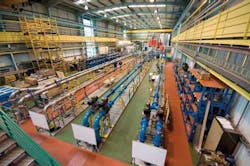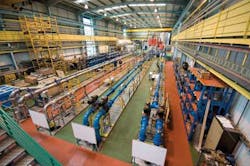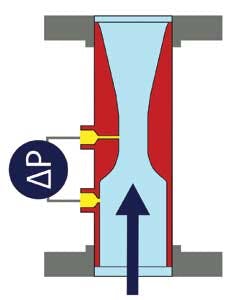Meters, sampling critical for effective multiphase flow management
Emmelyn Graham
NEL
Flow assurance is recognized as hugely important for the transportation of hydrocarbon fluids, since failures can be extremely costly to fix and can cause safety issues. In particular, flow assurance is vital for multiphase flows of oil, gas, and water mixtures.
The industry is trending towards the use of multiphase meters to measure these types of flow. Multiphase meters bring advantages such as lower capital and operational expenditure, increased capability to monitor individual wells in real time, reduced need for test separators and associated maintenance, and minimal loss of production through well shutdowns during tests.
For subsea activities, installing multiphase meters can provide further benefits such as a reduction in required piping infrastructure, and the capability to install meters on each well to continually monitor production. It also allows different operators to share pipeline systems, reducing cost and disruption, as individual well production can be metered before commingling.
In the majority of cases, multiphase meters' performance and accuracy depend on the accuracy of the fluid properties data employed for flow calculations. Pipeline fluid sampling of multiphase flows has become essential to ensure these data are accurate. Inaccurate mismeasurements can lead to large financial losses, misallocation of fluids, and exposure to increased flow assurance risks. Ideally, the industry would prefer multiphase flow measurement technology to be less sensitive to fluid properties.
Sampling is used to determine the composition of pipeline fluids and fluid properties for multiphase metering, and can identify the presence of components that could cause flow assurance issues such as build-up of deposits of scales and waxes in the line. Subsea sampling systems are now being developed, even though each subsea sample can cost as much as £500,000 (nearly $765,800). The reason is that the pay-offs can be worthwhile.
While early identification of flow assurance issues is crucial, cost and time associated with obtaining fluid samples can be significant too. Subsea sampling systems are being installed because the fluids obtained are representative of what is passing through the meter; whereas collecting fluid samples topside may not be. One reason is that organic components such as paraffins and asphaltenes may be deposited along the pipeline before the topside sampling position. Also, inhibitors may be injected after the meter, affecting the fluid properties in the collected sample; topside, the samples will be collected under different conditions, such as temperature and pressure.
Looking into the causes
Numerous factors need to be considered for multiphase and wet gas flow metering, including blocked impulse lines and deposits of solid material. Meters with moving parts can also become damaged by deposits and hydrate crystals.
For multiphase flows, issues include formation of waxes, hydrates, scales; restrictions and blockage of pipes; damage of equipment; and corrosion/erosion of pipe and equipment.
The design, modeling, and testing of subsea multiphase sampling systems has been crucial to eliminate the risk of failure to collect a sample. This failure can itself be caused by flow assurance problems such as blockages or formation of waxes and hydrates caused by temperature and pressure changes.
Hydrates are solid crystalline structures which are problematic because they can damage equipment and even block the whole pipeline. Hydrates forming in flow conditioners in gas pipelines can also affect the flow profile and the meter performance. Additionally, some oils contain wax molecules, which can in turn form wax particles at low temperatures, leading to deposition on the pipe wall or inside the meter. And, wax build-up can affect electrical detection of fluids; for example, if wax coats the electrodes in a multiphase meter.
Any type of deposit can lead to blockages in the pipe. If the multiphase flow meter has a Venturi tube (usually the case), this can also alter its dimensions, leading to errors and blocking of the line.
Scales are formed from inorganic chemicals present in the flow. While these can be treated using inhibitors, they are difficult to dislodge, and strong acids may be needed to remove them.
Blocked impulse lines for differential pressure type meters can be caused by hydrates, waxes and scales. Trace heating can be applied around impulse lines to limit the formation of hydrates and waxes, and many subsea meters use diaphragms at tappings to prevent build-up of solids. Operating temperature, pressure, and multiphase composition of the flow will determine whether asphaltenes also form, but unlike hydrates and waxes, these do not melt when heated.
Sand is undesirable in all types of flow, since it erodes pipe work, meters, valves, and other components. Unfortunately, there is no cure to combat such erosion, and once a component has become worn, the only option is to replace it.
While deposits of solid material can cause restriction of pipes and within flow meters, inhibitors injected into pipelines to mitigate flow assurance issues can also change the fluid properties and affect the meter response, if it relies on accurate fluid property data. Ideally, fluid sampling should be performed close to the meter to ensure the sample is representative of the fluid passing through it.
All this underlines importance of understanding the challenges of measuring individual components of multiphase fluids, as implementation is much more complex than metering the single phase components of just oil or water or gas.
Potential applications
Multiphase flow meters (MPFMs) can be applied to help predict flow assurance issues, production upsets, and changes. They principally operate by measuring the bulk flow rate of the multiphase mixture and calculating the individual phase fractions. These are then used to determine the flow rates of the individual streams within the mixture. Understanding the measurement techniques employed in a meter will help predict how it will be affected by flow assurance issues or changes in the fluid properties.
The following measurement techniques are commonly used in MPFMs.
Differential pressure (DP) meters can be used either to calculate the flowrate of the multiphase mixture or to calculate the density of the mixture. DP meters are extensively employed to meter wet gases, either by applying corrections to adjust for the presence of liquids or as part of a wet gas meter system.
Cross-correlation is where two sets of sensors look for correlated signals caused by flow disturbances such as slugs and bubbles. This does not work well in homogenous flow or where there is an emulsion, as by definition there is nothing to cross-correlate.
Electrical property measurements of the electrical impedance across the pipe can determine the electric properties of the multiphase mixture such as capacitance and conductance. Capacitance sensors work best in oil-continuous flow, while conductivity sensors work best in water-continuous flow. The results of these tests can then be used to determine the phase factions of the multiphase mixture.
Microwaves can be used in two ways to measure multiphase mixtures – resonance and absorption. Like electrical capacitance, microwaves exploit the difference in permittivity of the multiphase components to determine the individual phase fractions of the mixture.
Gamma ray attenuation is another option. The most common nuclear sources used are Barium 133, Caesium 137, and Americium 241. The number of gamma rays passing throughout the pipe depends on the composition of the multiphase mixture inside the pipe and therefore indicates the composition of the flow. For example, gas is a weak absorber of gamma rays, while water is a stronger absorber.
Partial separation combines the elements of MPFMs with separation techniques, and is particularly useful when the multiphase mixture has a high gas volume fraction greater than 95%. Partial separators employ a device that separates the gas and liquid streams to be measured.
Future hydrocarbon management
Flow assurance will continue to be important in hydrocarbon management, especially for multiphase flows. Use of MPFMs to monitor production and for allocation is set to continue due to the advantages and cost reductions that they deliver. However the complexity of these technologies also increases the cost of the meter, so meter longevity becomes critical, especially taking into account the additional cost of subsea meters and the associated issue of meter accessibility. There is a vicious circle, because while multiphase flow meters can be affected by existing flow assurance issues, they can also be used to identify potential flow assurance problems. Regular and representative fluid sampling is therefore essential for identifying flow assurance issues that may impact their reliability.
Offshore Articles Archives
View Oil and Gas Articles on PennEnergy.com




